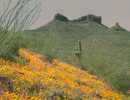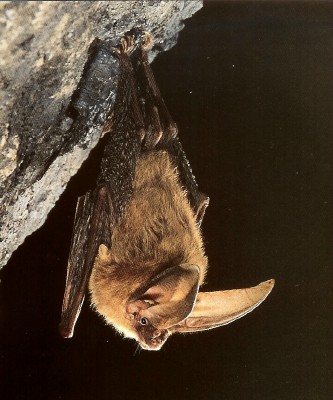
Cabeza Prieta Natural History Association
Sonoran Desert Mammals

Townsend's big-eared bat
(Plecotus townsendii)

|
Diet: moths
Size: weight 8-14 grams (0.3-0.5 ounce) wingspan 30-34 centimeters (12-13 inches) Active Period: nocturnal |
These bats hibernate in caves or mines where the temperature is 54 degree or less, but usually above freezing. Hibernation sites in caves often are near entrances in well-ventilated areas. If temperatures near entrances become extreme, they move to more thermally stable parts of the cave. They hibernate in clusters of a few to more than 100 individuals. During hibernation, the long ears may be erect or coiled.
Solitary bats sometimes hang by only one foot. Maternity colonies are located in relatively warm parts of the caves. During the maternity period, males apparently are solitary. Where most males spend the summer is unknown. No long-distance migrations are known. Like many other bats, they return year after year to the same roost sites.
Mating begins in autumn and continues into winter; the sperm are stored during winter, and fertilization occurs shortly after arousal from hibernation. One baby is born in June. Babies are large at birth, weighing nearly 25% as much as their mother. They can fly in 2.5-3 weeks and are weaned by 6 weeks. Lifespan of the Townsend's big-eared bat may be 16 or more years.
This article is from "Bats of the United States", 1999, by Michael J. Harvey of Tennessee Technological University, J. Scott Altenbach of the University of New Mexico, and Troy L. Best of Auburn University. Published by the Arkansas Game & Fish Commission, in cooperation with the Asheville Field Office of the U.S. Fish and Wildlife Service.
Photo Credit:
Photo #1
Copyright Creative Commons
HTML & Programing by
Thomas R. Powell